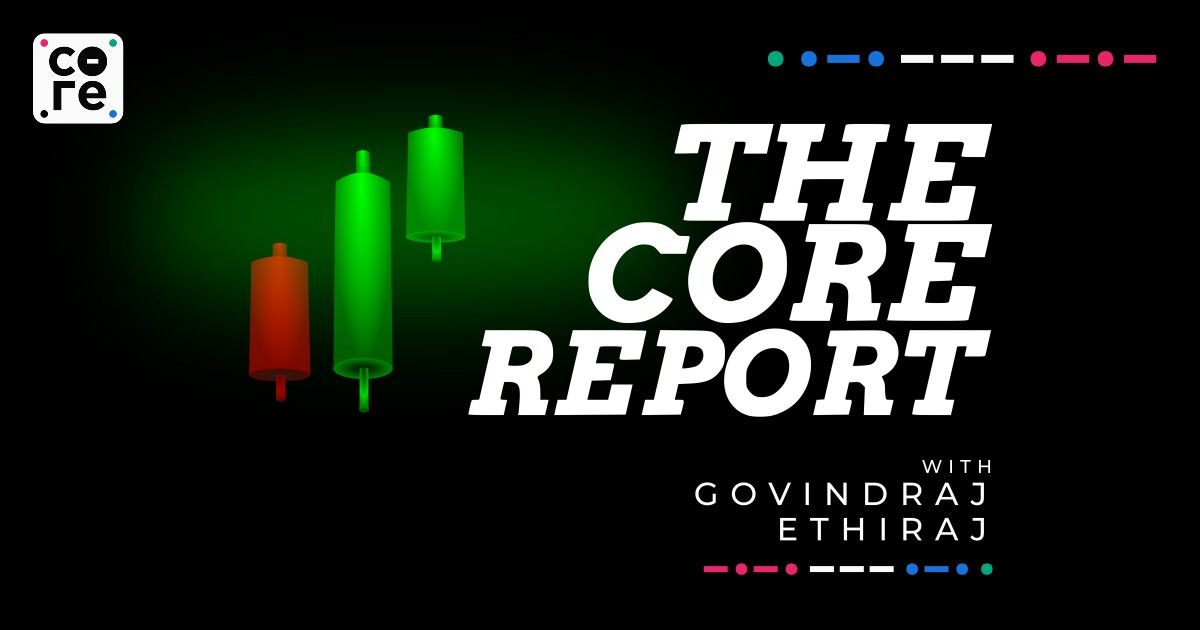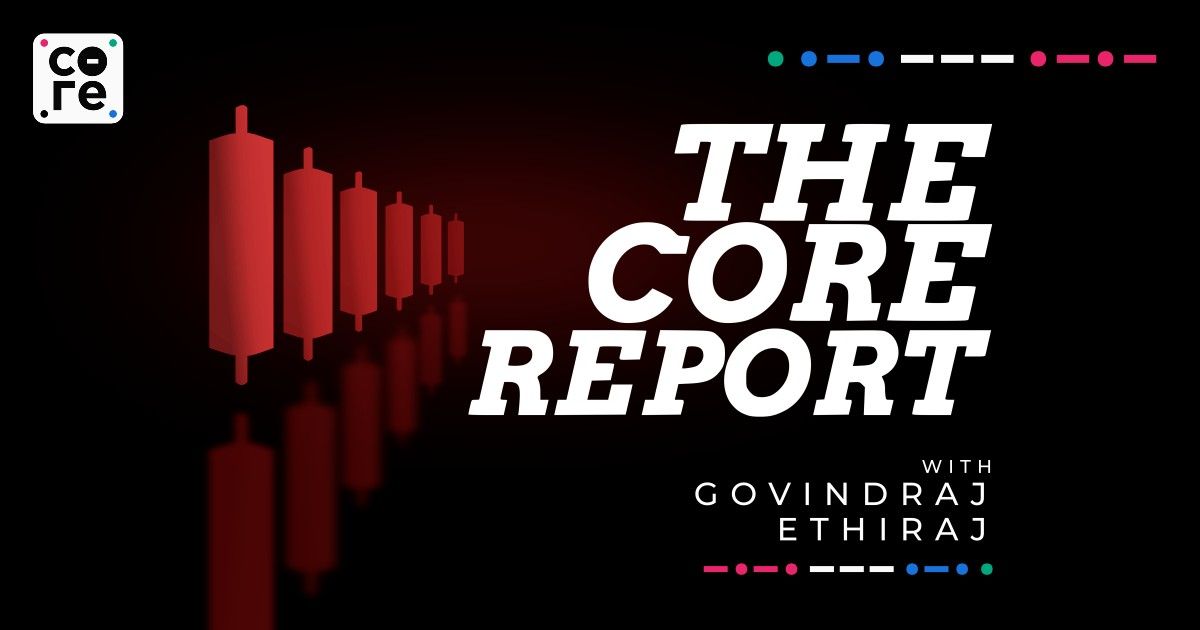On today’s episode, we feature an excerpt from our upcoming weekend edition which features financial journalist Govindraj Ethiraj in conversation with Rama Bijapurka.
Our Top Reports For Today
- (00:00) Stories Of The Day
- (01:00) Gold continues its run, hits fresh high in anticipation of interest rate cuts.
- (03:46) RBI & SEBI move in concert in near and rare co-ordinated actions.
- (06:20) Passenger vehicle sales continue to surge.
- (07:27) What the RBI Governor thinks of Ferraris.
- (09:22) More airports coming in India, global air traffic up 17% in January.
- (13:09) Breaking down the old rural-urban consumer divide with Rama Bijapurkar
NOTE: This transcript contains only the host’s monologue and does not include any interviews or discussions that might be within the podcast. Please refer to the episode audio if you wish to quote the people interviewed. Email [email protected] for any queries.
—
Markets Steady, Gold Up
The markets stayed steady for another day, largely on expected lines as markets rarely hold on to gains beyond a few days and appear to move in an upwardly moving band.
I guess the point is that it is moving upward
The BSE Sensex ended at 74,119, up 33 points while the Nifty50 closed at 22,493, up 20 points.
Among top large-cap gainers, Tata Steel, JSW Steel, Bajaj Finserv, Tata Motors, Bajaj Finance, ITC, Asian Paints, Nestle India, and TCS gained over 1 per cent.
Gold as we spoke yesterday continues to race away setting a new record globally. Other precious metals also went up sharply after Federal Reserve Chairman Jerome Powell reiterated the US central bank will likely cut interest rates this year.
Bullion hit a fresh high of $2,152.25 an ounce, while palladium broke the $1,000-an-ounce mark with gains of more than 10%, Bloomberg reported..
Powell reportedly said in senate hearings it will likely be appropriate to begin lower borrowing costs “at some point this year,” but made clear they’re not ready yet. He also said he’s not looking for inflation to reach the central bank’s 2% target to start easing policy.
The market has seen some interesting expectation management. Going by the earlier prognosis, the interest rate cuts or the first of them in the US should have happened about now, in the month of March 2024.
Obviously they are not because the potential cut was pushed to June which is when most people are expecting it to happen now.
Gold’s has climbed 5% over the last five sessions, a move that has surprised some in the markets, Bloomberg said, because there has been no major change in expectations for when the Federal Reserve will lower borrowing costs.
Like I said, June is the month in the cross hairs either way. From a markets point of view bullion makes sense when interest rates drop because of the likelihood of appreciation.
The Rupee Is Stronger
Back home, the Indian rupee ended strong on Thursday after hitting its highest level in six months during the session, Reuters reported.
The rupee closed at 82.78 against the U.S. dollar, compared with its close at 82.82 in the previous session..
While the rupee climbed to a peak of 82.73, the highest level since September.
The rupee is, as we have discussed here, moving in a band as well but one where the Reserve Bank has some role to play.
Reuters said the dollar index, a closely tracked global indicator and trigger for other currencies, was down slightly at 103.18, hovering close to its weakest level in a month on Wednesday. Other Asian currencies are also strengthening by the way.
Financial Regulators Are Coordinating Their Attacks
It is quite clear as we have been discussing that the financial regulators have been tracking a potential system risk in banking and financial markets for more than a year or two now, given the various actions, with some very visible, like a business ban on PayTM banks, specific product or service bans on Bajaj Finance, IIFL Finance and now JM Financial.
It is also clear that the primary regulators, Securities & Exchange Board of India and the Reserve Bank of India are synchronising to some if not a great extent.
On Thursday, the Securities and Exchange Board of India (Sebi) barred JM Financial from acting as a lead manager for any public issue of debt securities due to a violation of regulations.
The regulator has passed an interim order against the firm on this matter.
This comes after the Reserve Bank of India (RBI) barred JM Financial Products Ltd from doing any form of financing against shares and debentures due to certain serious deficiencies with respect to loans sanctioned by the company for IPO financing as well as NCD subscriptions.
Sebi says it undertook a routine examination of the public issues of non-convertible debentures (NCD) during the year 2023 and found that a very large percentage of securities issued changed hands on the day of listing as a result of which, retail ownership came down sharply.
On further examination, Sebi says it found that JM Financial Products, the non-banking finance subsidiary of JM Financial, acted as a counterparty to the trades of these individual investors and had also provided the funds deployed by these investors for subscribing to the issue.
On the very same day, JM Financial Products offloaded at a loss, a significant portion of the securities that it had acquired from these investors to corporate investors.
Prima facie, it was noted that the scheme involved getting individual investors, who would otherwise not have participated in the issue, to make applications not just by providing funds to them, but also by assuring them an exit at a profit on the listing day.
At this point, it is pretty interesting and reflects obviously the hunger and desperation of investors to ride on a booming IPO market, as was evident earlier as well.
Sebi said that market integrity and fair price discovery have been compromised.
In case of the existing mandates where JM Financial is a lead manager, it has been allowed to remain so for a period of 60 days from the date of this order.
Auto Sales Are Strong Again
Passenger vehicles (PVs) saw a record-breaking February, with sales moving up by 12 per cent to 330,107 units as compared to 293,803 units in February last year.
India’s automobile retail sales were up 13 per cent in February to 2.03 million units, compared to 1.79 million units in February 2023.
The Federation of Automobile Dealers Association attributed this to enhanced vehicle availability, improved demand due to economic conditions, and the impact of marriage season.
“The PV segment recorded a 12 per cent YoY growth, marking the highest February sales figures ever, driven by new product introductions and enhanced vehicle availability.
Elevated inventory levels in the PV segment, remaining at 50-55 days, pose a significant concern, necessitating original equipment manufacturers to adjust production to reduce dealer carrying costs,” said Manish Raj Singhania, president of FADA.
General elections will sweep the country later next month and auto dealers feel that this could lead to deferred purchases.
Every other vehicle category, including two-wheelers, three-wheelers, tractors, and commercial vehicles, registered growth rates of 13 per cent, 24 per cent, 11 per cent, and 5 per cent, respectively.
Two-wheeler demand is strong, also thanks to more products, models and premium products.
Interestingly, the 3W growth represents 53% of total growth.
“The 3W market surged by 24 per cent, with EVs making up 53 per cent of this growth, fuelled by first-time users and a shift towards Electric E-Rickshaws, alongside better market sentiment and consumer engagement,” Singhania said. In February, three-wheeler sales touched 94,918 units, compared to 76,619 units in February 2023.
The commercial vehicle segment grew by 5 per cent.
Ferrari’s And RBI
I know we seem to be spending a fair amount of time on the REserve Bank’s actions and reactions. But I must return to it for a moment for what I would call a flavour story.
Most of our discussion has been on the action of it and perhaps the logic of it, as viewed by The Core Report.
And then, as banking journalist Tamal Bandyophadyay pointed out earlier this week, this is a new RBI.
The new RBI governor pointed out in an interview to television station ET Now that the the RBI acted against PayTM Payments Bank because of consistent non compliance rather than a grudge (my words) against fintech companies.
He also added, in a term and phrase that is indicative of much more than just a car going fast that you may own and drive a Ferrari but one still has to obey traffic rules to avoid accidents.
The use of the word Ferrari, if I might take a few liberties is not accidental. Rather it reflects a clear disdain of not so much the car in question or its value – of course it also reflects the value – but the people who likely would buy such a car, with the greater intention of breaking the rules rather than to be the proud owner of a fine and legendary piece of engineering.
It also reflects the regulators increasing irritation with 40-year-old venture funded entrepreneurs with evidently and often zero understanding of trust or risk lecturing the Reserve Bank and other regulators on how they are perhaps behind the times when it comes to technology.
The governor also pointed out that he was focussed on entities that were regulated by the Reserve Bank and not other companies within, lets say, the PayTM combine.
But then, Sebi is regulating the listed company that has an ownership of PayTM.
While there is nothing to indicate that any action is coming from Sebi right now but it is very likely there would be some form of coordinated inquiry and examination of the business.
New Airports Are Coming
On the last day I caught two flights from Mumbai to Delhi and back and both were delayed by an hour.
Air India, which of course could borrow a whole book on passenger service from its sister company Vistara, was an hour late leaving Mumbai.
Vistara to be fair was late by an hour out of Delhi – apparently also because of runway restrictions in Mumbai – but the experience was not chaotic as in Air India where there appeared to be no S.O.P for boarding passengers and appeared to be a fresh pattern randomly thought of at that very moment by the gate manager.
Mumbai of course is constrained till the new airport in Navi Mumbai across the harbour kicks off next year, if it is on time, but the new runways in Delhi do not seem to be making much difference in Delhi either. This is my experience from several flights in and out.
Meanwhile, I guess one can hope that your point of origin and destination are some of the newer airports.
The Government is reportedly lining up inauguration of 15 airport projects, the Economic TImes says adding Prime Minister Narendra Modi will inaugurate the projects which includes new terminals of Delhi, Lucknow Airport and Pune airport.
The other projects include new airports in Uttar Pradesh at Chitrakoot, Shavasti, Azamgarh, and new terminals at Belgaum, Hubli in Karnataka Jabalpur and Gwalior in Madhya Pradesh.
Delhi airport is also building larger terminals to double its capacity from 20 million to 40 million.
Elsewhere, airports like Lucknow are seeing massive expansion and investments.
On the other hand, India’s airport infrastructure appears severely strained already, at least in the metros. Aviation consultancy firm CAPA has said that Indian airlines have an order book of 1618 aircraft-2.5 times the size of their existing fleet, according to aviation consultancy firm CAPA.
Global air passenger traffic up in January
Speaking of aviation infrastructure, air traffic and demand measured in revenue passenger kilometres was up almost 17%, while capacity measured in available seat kilometres was up around 14% in the month of January, indicating a strong start to the year, latest figures from the Geneva based International Air Transport Association showed.
Within that, international demand grew faster at 21% versus domestic demand which grew at 10%.
So whether you are flying within the country or outside, chances are seats are tough to get or prices are trending higher.
There is a good reason. Asia Pacific airlines saw a 45% increase in January 2024 traffic compared to January 2023. The big jump in the region of course was driven by China.
So, within the region, IATA says recovery in major international routes to and from Asia-Pacific are still lagging but Asia-Middle East have exceeded pre-pandemic levels.
We have said earlier how airports like Dubai are nearing their pre-pandemic record traffic levels of 89 million, set in 2018 though.
Last year, Dubai saw 87 million visitors, crossing the 2019 figure of 86.4 million. Meanwhile, passenger load factor, a good indicator of how airline’s bottom lines are doing, was almost 80%, marginally higher than the same month last year.
“2024 is off to a strong start despite economic and geopolitical uncertainties. We will be looking to governments for policies that help aviation to reduce costs, improve efficiency and make progress towards net zero CO2 emissions by 2050,” said Willie Walsh, IATA’s Director General
Finding India’s Consuming Class
Estimating the size and buying power of Indian consumers and by definition understanding consumer markets as a whole is a favourite pastime for many, mostly to see how people have got it wrong and repeatedly so.
Business analyst and long term observer of India’s consumer, Rama Bijapurkar is back with a fresh book, this time looking at the lilliputs in Indian markets, emphasising the importance of granular understanding of how Indians consume and why.
I caught up with her for The Core Report’s weekend edition that plays out on Saturday. One question I asked is of course what had changed among Indian consumers and what differences were there if any and of course the famous rural urban mix.





